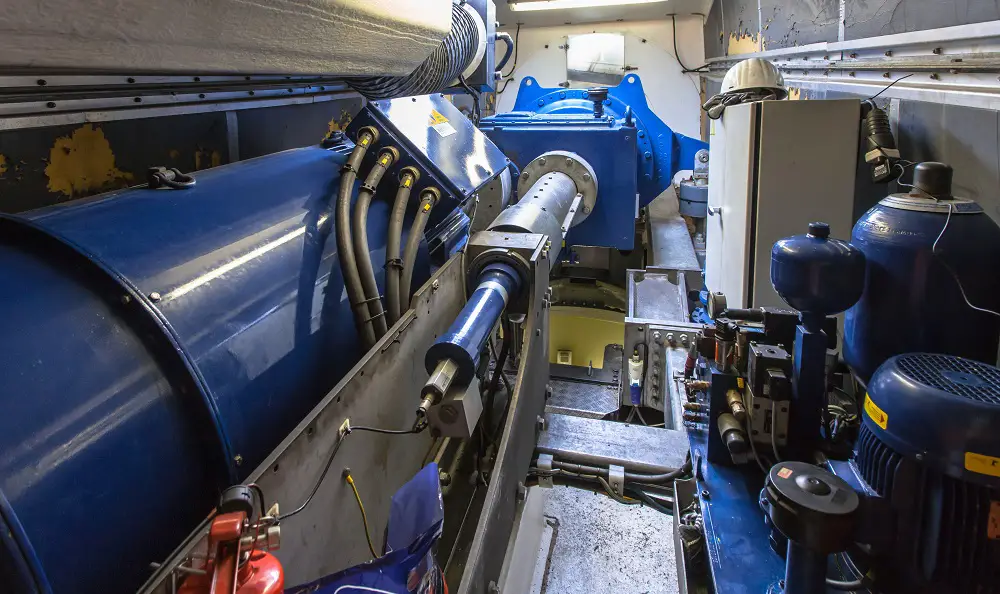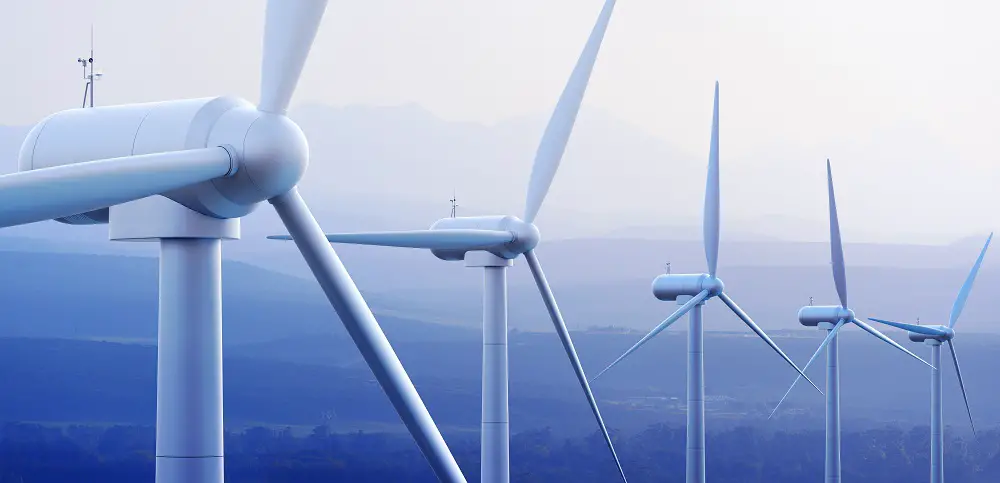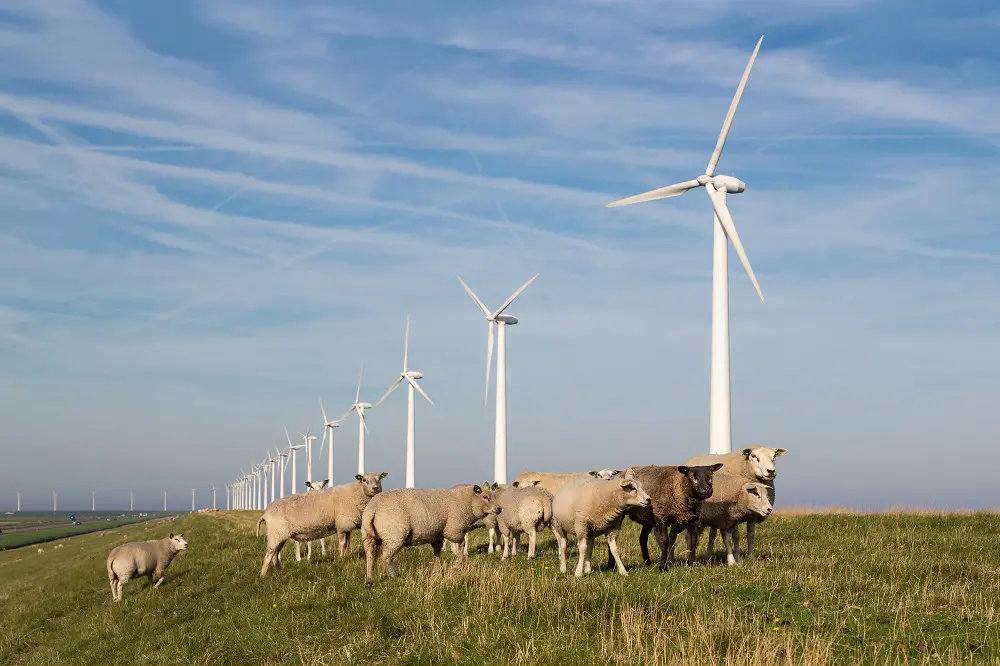Insufficient Wind
The most obvious reason that a wind turbine would stop is that there is no wind to blow on it. If there is no wind, the turbine cannot rotate.
Overview of Wind Speeds
Meteorologists (weather scientists) measure wind speed in knots, which are almost the same as miles per hour (1 knot = 1.15 mph)1. Wind speed is sometimes also measured in meters per second.
The Beaufort Scale
The Beaufort Scale is sometimes used to describe wind speed, relating it to the observable effects of the wind2.
This scale goes from Wind Force 0 (Total calm – smoke rises vertically, water surface like a mirror) through Wind Force 3 (Gentle Breeze – leaves and small twigs in constant motion; light flags extended) and Wind Force 6 (Strong Breeze – large branches in motion; whistling heard in telegraph wires; umbrellas difficult to use) all the way up to Wind Force 12 (Hurricane – Buildings devastated)

Start-up Speed and Cut-in Speed
All wind turbines have what is called a ‘start-up’ wind speed and a ‘cut-in’ wind speed. The two are related, but different.
The start-up speed is the minimum wind speed that is needed for the turbine to actually start rotating.
Note that at this very low speed, the turbine cannot generate any electricity. The cut-in speed is a bit higher than the start-up speed, and this is the speed that the turbine starts generating electricity.
The cut-in wind speed for modern grid scale wind turbines is between 6-9mph (Beaufort Wind Force 3 – Gentle Breeze).3
Deliberate Turbine Shut-Down
Sometimes when you see a wind turbine that is not rotating, it is not because there is no wind – it is because the turbine has been deliberately shut down. There are a number of reasons why a turbine would be shut down even while the wind is blowing:
1. Routine Maintenance or Emergency Repair

Being a mechanical device, there are moving parts inside a wind turbine (gearbox, axles etc) that require routine maintenance to keep them operating at maximum efficiency. Whilst workers are carrying out routine maintenance or emergency repairs to a turbine, it must be first shut down to keep the workers safe. As soon as the maintenance or repair is complete and the workers are safely away from the turbine, it can be allowed to re-start.
2. Wind Speed too High – Furling Speed
As wind speed increases, the wind turbine will reach what is called its ‘rated speed’. This is the wind speed at which the turbine generates maximum electricity, and for a modern grid-scale wind turbine, this is about 25mph4 (Beaufort Wind Force 6 – Strong Breeze).
If the wind speed continues to increase, the blades spin faster and faster, and this is not desirable. The turbine needs to be kept within its rated speed for maximum generation efficiency. This is done by slowing down the blades using a process called pitch control or blade feathering. Blade feathering is when the angle of the turbine blades is twisted so that they pick up less of the wind and so keep rotating at the rated speed even as the wind speed increases.
If the wind speed continues to increase, all wind turbines have a maximum wind speed above which they cannot operate. This is called the turbine’s ‘furling speed’. If the wind speed exceeds the furling speed (for example in a hurricane) the turbine has to be shut down to prevent the blades getting damaged. A modern grid-scale wind turbine has a furling speed of about 55mph (Beaufort Wind Force 10 – Storm). Once the wind speed drops back down safely below the furling speed, the turbine can be allowed to restart and continue generating electricity.
3. Oversupply of Electricity to the Grid
Every country has a National Grid whose job it is to keep electricity flowing for all electricity users – domestic, commercial and industrial –24 hours a day, 7 days a week. The National Grid don’t generate the electricity themselves, they just manage the electrical pylons and cables that transport the electricity around the country from the generators (nuclear power plants, coal/gas power plants, wind farms, solar farms etc) to the customers.
The amount of electricity being used nationally changes all the time, for example overnight there is a lot less demand for electricity. The National Grid has to make sure that the amount of electricity being generated is the same as the amount being used, and this is called ‘balancing the grid’.
As demand for electricity falls, the National Grid will tell different power plants to decrease the amount of electricity they are generating, or even to shut off generation completely to keep the grid balanced.
Shutting off wind turbines is a lot easier and cheaper than shutting off a coal-fired power plant, and so wind farm operators are normally the first to be asked to shut off as national demand for power decreases. When a wind farm operator receives a shutdown request from the National Grid, they will shut down their turbines, even if the wind is still blowing.
4. Constraint payments
Some countries operate a system called ‘Constraint Payments’. This system means that if a power generator has been asked to shut down by the National Grid, they are still paid for the electricity that they could have generated, had they not been asked to shut down. This ensures a reliable income stream for the generator and improves energy security for the country.
In Scotland, UK, during the story winter months in 2020 there was so much wind power being generated that wind farms had to be shut down for weeks at a time.5 This is obviously a huge waste of potential generation that could be put to good use, but that is a matter for a separate article.
Shutting Down a Wind Turbine
If the decision is taken that a turbine needs to be temporarily shut down, for whatever reason, there are a few methods usually employed to stop the turbine rotating.
1. Electromagnetic Braking
A wind turbine can be made to slow down by increasing the electrical load (resistance) connected to the turbine’s generator. This is called electromagnetic braking, and is usually the first method that is used to start slowing the blades.
2. Mechanical (Friction) Braking
This is exactly the same system as the brakes in a vehicle – a mechanical clamp closes on a rotating disc and the friction of the clamp slows down the rotation of the shaft to which the disc is attached until it eventually comes to a complete stop.
How Do Wind Turbines Work When it’s Not Windy?
Sometimes at ground level, it might feel like there is no wind, yet you can still see wind turbines rotating. This is because at higher altitudes, the wind speed increases.
Even when there is no wind at ground level, there can still be a significant wind speed at the height of the turbine, so it is not uncommon to see turbines rotating when it feels like there is no wind.




